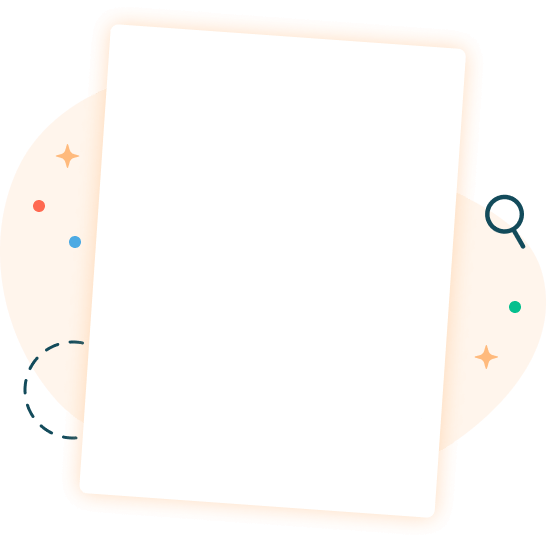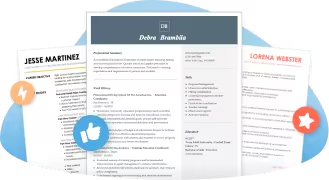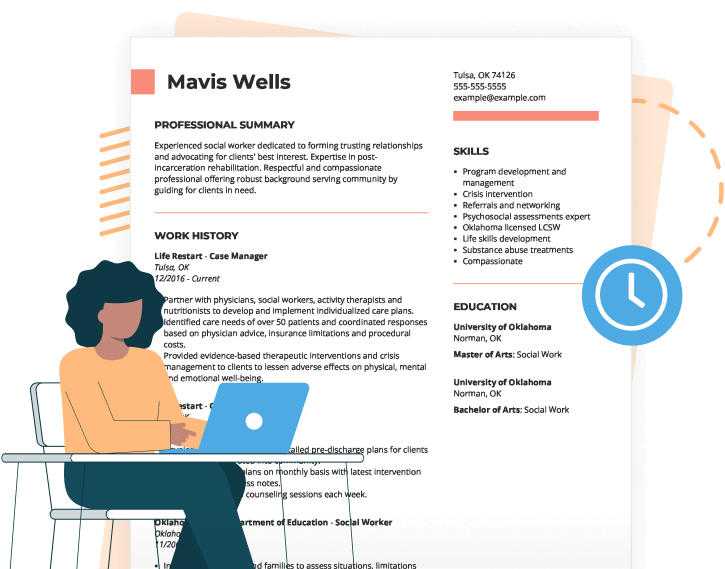Featured Resume Examples
Among our highly-requested resume examples are fashion designer, fashion merchandiser and costume designer. Looking for another job title? Scroll down a bit, there are plenty more below.
Search Fashion Jobs
Fashion Resumes by Job Title
Find the resume example you need by browsing these specific Fashion categories:
Specialized Technical Support Roles (2)
Consulting Roles (2)
Design Roles (4)
Production Roles (4)
Retail and Merchandising Roles (7)
Support Roles (5)
Cover Letter Examples for Fashion Jobs
Job Outlook
The fashion industry is constantly changing, and the outlook for jobs differs according to each role and the demand for professionals.
The job growth for models is expected to increase 1% up until 2029, much slower than the national average, reports the U.S. Bureau of Labor Statistics.
This sluggish increase is due to modern advertising trends and no longer needing to rely so heavily on live models to promote products.
Fashion designers will have it tougher than models since their jobs are expected to decline by 4% between 2019 to 2029.
To navigate the fashion industry, you’ll need a precise and compelling resume. Keep reading to discover JobHero’s top writing tips for the best fashion resume.
3 Tips for Writing Fashion Resumes
Choose the right format for your resume
Professionals in the fashion industry will be glad to know there are resume formats tailored to their specific work experience.
There is no one size fits all, but by calculating how long you’ve been in the workforce, you can determine which format fits you.
TFor example, if you’ve been a fashion designer creating beautiful apparel for five years or more, your resume should be in a chronological format.
This format emphasizes your long career and knowledge of the fashion industry.
Professionals who’ve worked between three to five years you should consider using the hybrid format.
Hybrid formats also work well for people seeking a promotion. For instance, if you’ve worked as a fashion stylist for multiple editorials and you’re ready to become a magazine’s fashion editor, the hybrid format will showcase all your talents and experience while giving you space to promote the skills that make you capable of reaching this higher level.
The functional format is made particularly for individuals with work experience of two years or less.
If you’re trying to get your foot in the door of the fashion industry as a budding fashion assistant, the functional format is excellent for highlighting all the skills you need to thrive in your new job.
Promote your skills
The fashion industry is fast-paced and very demanding of its workers, so having an impressive and diverse skill set is a must for any position.
Browse this list of professional skills and include six-to-eight that accurately represent you professionally.
- Creativity
- Sense of style
- Trend forecasting
- Detail-oriented
- Adaptability
- Team player
- Competitive spirit
- Communication skills
- Customer service
- Decision-making skills
- Business administration
- Business relations skills
- Financial skills
- Negotiation
- Sales
- Networking
- Fashion marketing
- Merchandise management
- Inventory management
- Curation of merchandise
- Presentation standards
- Visualization standards
- Pattern making
- Tailoring
- Sewing
- Fabric awareness
- Styling
- Photo editing skills
- Inter departmental management
- Proficiency in fashion software e.g., AutoCAD, Sketchbook, C-Design Fashion, Adobe Illustrator, Photoshop
Pay close attention to the job posting or description for key skills they’re looking for in their candidates.
Some employers will want fashion designers to have some solid sewing and pattern-making experience whereas others might prefer designers with strong business skills to move the brand forward.
Use a template to make your resume unique
In the fashion industry, expressing your style is not only encouraged, it’s a fundamental necessity.
Your fashion resume doesn’t need to be traditional — instead, you can opt to show your creative side by exploring some of JobHero’s resume templates.
These templates offer form and function. They’re designed to fit in all your information in the most optimal way, all framed within beautiful designs.
Browse all of our templates where you can find one for any role, whether that’s a bold template for a fashion designer, or a sleek and timeless design for a fashion editor.
And if you want the easiest possible experience creating your resume, use JobHero’s Resume Builder for an immersive resume-writing experience.
Fashion creatives will feel right at home with the builder since you can customize further details like font, spacing and colors with ease to truly make the resume your own.
At the same time, you’ll get valuable pro tips and auto-suggested phrasing written by career experts based on your job title.
Fashion rookies will find this to be a lifesaver when in need of help applying the correct fashion marketing jargon.
The Resume Builder will be like your own personal guide, so that you can tackle the fashion industry by storm!
FAQ
What should I put on my fashion resume?
Before you begin to write your resume, you need to consider its five main sections: contact information, professional summary, work history, skills and education.
Your most important information will be divided between your work history and skills, so you should be taking your time with these sections in order to narrow down what’s most relevant.
Sometimes your work history can end up becoming repetitive or lackluster, which is why we recommend you quantify your accomplishments.
Including numbers, statistics and dollar amounts in the descriptions of your work history will grab employers’ attention and show them you have a sharp mind for the financial aspect of your job.
Some quantifiable achievements a fashion designer could include in their resume are:
At the end of the day, what matters in the fashion industry is that all that creativity and boldness translates into sales that bring in more revenue.
How should I include a portfolio with my fashion resume?
For many — if not most — fashion industry jobs, you need to show employers a sample of your work. The way to do this is by including a portfolio alongside your resume.
Portfolios are useful to demonstrate many types of work like apparel design, fashion photoshoots, catwalk production, or branding and media plans.
Creating a physical book for your portfolio is tradition in the fashion world, and you would do well to always have that staple if you’re applying in person or have been selected for an interview.
However, with the modern state of fashion and the importance of online media presence, hosting your portfolio online is a practical option. It allows your work to be accessible to anyone at all times.
Lots of designers use platforms such as Behance, Wix or WordPress and include a hyperlink in their resumes.
Models and fashion designers in particular should include their professionally-dedicated social media accounts, especially if they have a large social media following. An impressive amount of followers means your presence in a brand could exert influence over consumers, which is highly attractive to employers.
For example, below the email address in your contact information, you can add:
www.————–.com/design-portfolio
See more @elise_steuwe on Instagram, Facebook and Twitter.
Another great place to include your portfolio is in your cover letter since you can explain how its core concepts match the needs or values of the company to which you’re applying.
How much money do people in the fashion industry make?
The Bureau of Labor Statistics reports that the median annual wage for fashion designers is $73,790.
The apparel, piece goods and wholesale industries have the highest employment of designers — around 8,000 individuals in 2019 — that make an annual mean wage of $85,000.
According to the Fashion Institute of Design and Merchandising (FIDM), fashion merchandising buyers can make around $124,000 per year at companies like Coach, Calvin Klein, Forever21, Target and more.
Occupations like seamstress, fashion sales associate and fashion models average between $20,000 to $50,000 in annual salaries.
As with any job in the fashion industry, a lot has to do with your level of experience and the company for which you work. Usually bigger brands offer bigger salaries, so keep that in mind when applying for jobs.
What kind of work experience should I put on a fashion resume?
Your work experience on a fashion resume should include relevant occupations, and convey your good taste and sense of style.
Of course, if you already have experience in fashion, include that first in your resume. Individuals with a long career should pick the work history most relevant to the job to which they’re applying.
Remember that your resume doesn’t need to include every single job you’ve had. Three to four previous jobs is the standard for any average professional.
In the fashion industry, sales knowledge and business skills are highly regarded alongside artistry and creativity. If you’re lacking in creative experience, add any jobs in marketing, merchandising or sales that show you can handle the business side of fashion.
It’s important to be wary of not leaving out huge gaps in your resume so as to not raise any red flags. If you do have any gaps, make sure to address them in your cover letter.
Should I include a cover letter with my fashion resume?
Absolutely. A cover letter is a fantastic way for fashion industry professionals to show their unique abilities.
A cover letter helps you tie in your work history and skills in a logical way. For example, if you included pattern making and leadership skills in your resume, in your cover letter you can explain how you offered training to the seamstress staff as a junior technical designer — an impressive feat!
Professionals who are seeking a promotion can use a cover letter to eloquently narrate their career progression.
If you’re aiming for a higher position at the company where you work, you can write about how you started from the bottom as a fashion assistant and took advantage of opportunities to become lead fashion designer in one year.
Cover letters allow you to be creative in how you present yourself professionally, a task which encompasses all the talents you need to be successful in the fashion industry: creativity, analytical thinking, good communication and being a confident vendor. JobHero offers fashion cover letter examples you can use to demonstrate these abilities and excel in your future job hunt!







